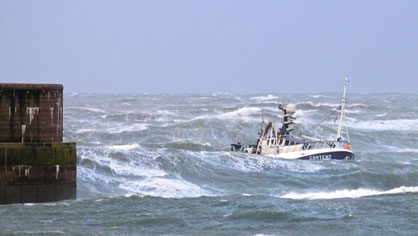21 May 2011
A meeting held recently in Copenhagen and attended by the NFFO, assessed the progress made to date in introducing a catch quota system.
This is the system that has been on trial for three years in the North Sea and documents all catches (not just landings) using CCTV which records all fish as it comes aboard; this may be one of the ways in which it will be possible to revoke large areas of complex and often counterproductive CFP rules as well as reducing discards. The meeting, organised by the Danish Fisheries Ministry was attended by a large number of fishing industry, scientific and fisheries management representatives. The meeting was used to discuss the strengths and weaknesses of the catch quota system and its future potential.
The key feature of a catch quota system is that it accounts for all catches, including discards, by verifying logbook information using CCTV cameras which record everything coming aboard. This very precise information can be tied to a reward system that encourages vessel operators to adapt their fishing patterns to meet management objectives. These incentives compensate skippers for the additional scrutiny and hassle factor associated with operating the catch quota system.
At present the catch quota system is used by 12 English and 26 Scottish vessels in the North Sea cod fishery and 2 vessels in the Western Channel sole fishery. Trials and operational schemes are also in place in Denmark, the Netherlands, Germany, Sweden and France. In the case of the cod fishery, the catch quota vessels are offered additional cod quota and more relaxed days-at-sea restrictions but must stop all fishing (for all species)when the cod quota is exhausted, whether or not they have other unutilised quotas.
On the evidence so far, catch quotas have a role to play in the move towards fully documented, low discard, fisheries that are the increasingly obvious destination for all European fisheries. But catch quotas do not necessarily have to be the only way that this is achieved. The application of a catch quota system is not without its difficulties, particularly in the demersal mixed fisheries. The meeting was adamant that there should be no automatic or blanket extension of the catch quota system to other stocks or fisheries, without carefully, on a case by case basis, evaluating and addressing the specific mixed fishery issues in each. Some novel suggestions were put forward for dealing with “choke species” (minor stocks that are in robust health but could close the fisheries for principal stocks simply through quota exhaustion). It was suggested that grouping such stocks in the way that is done currently for “Norway Others” may offer a way forward in these fisheries.
One of the main themes of the meeting was focused on the areas of CFP micro-management that could be removed for those vessels operating under catch quota schemes. It was agreed that it would be necessary to retain catch limits, although these could be made much more flexible than the currently are, through opening up in-year swaps and transfer arrangements. Likewise, it was considered inevitable that catch quota vessels would continue to observe some closed areas put in place for the protection of vulnerable habitats or species. But effort control and many of the technical conservation rules could be safely removed for vessels under catch quotas because they no longer serve a purpose if all catches (and therefore fishing mortality) are already fully accounted for. Similarly it makes little sense to require a catch quota vessel to observe real time closures as the authorities have confidence that the vessel will stop fishing when its cod (or whatever other species is used as the key) is exhausted, and it makes little of no difference whether that fish is caught here or there; or earlier or later in the year. It will make a big difference to the vessel though, and that is why skippers will aim to maximise income over the year to avoid cod if there is any danger that by catching too much of it his business could be put in jeopardy by a premature closure. Decisions on where to fish, when to fish and with what gear is used, lies with the skipper, as long as the vessel delivers the results. This contrasts starkly with the detailed prescriptive micro-management that currently applies. And that is why this approach is called results based management.
The essence of the catch quota system is to provide the skipper with maximum freedom to catch his quota allocations, in return for his commitment to fully account for the totality of his catches and to stop fishing completely when the key quota is exhausted.
The meeting concluded that catch quotas could only be extended to other stocks and fisheries in an incremental way, fully taking into account the specifics of each fishery. Abandoning a voluntary, incentivised, approach for a blanket requirement, as suggested recently by the Commissioner, would alienate fishermen yet to be convinced of the merits of catch quotas and undermine all the hard work that has been done to get to this stage.

